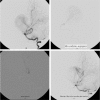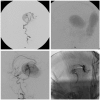Endovascular Management of Vein of Galen Aneurysmal Malformations: A Retrospective Analysis over a 15-Year Period
- PMID: 31308867
- PMCID: PMC6613484
Endovascular Management of Vein of Galen Aneurysmal Malformations: A Retrospective Analysis over a 15-Year Period
Abstract
Objectives: This retrospective study was aimed at assessing our results of endovascular management in vein of Galen aneurysmal malformation (VGAM).
Materials and methods: This is a retrospective study of 26 patients of VGAM who underwent endovascular treatment between 1998 and 2012. All patients underwent trans-arterial embolization. Of 26 patients, 23 were treated using n-butyl cyano acrylate (Glue), while 3 out of 26 patients were treated using the ethylene vinyl alcohol (EVOH) copolymer.
Results: Ages of the treated patients ranged from 1 day to 18 years of age. Of the patients treated, 17 were males and 9 were females. Around 15 of the VGAMs were of the mural variety and 11 were choroidal in nature. A good outcome was seen in 22/26 (85%) of the patients. Complications were seen in total in 7/26 patients (26.92%) of which 3/26 (12%) has a fatal outcome.
Conclusion: Endovascular embolization for VGAMs is highly efficacious and has helped create a population of VGAM survivors in this condition, which until only a few decades ago caused high mortality and morbidity.
Keywords: EVOH; Onyx; Vein of Galen aneurysmal malformations (VGAMs); glue; vein of Galen (VOG).
Figures






Similar articles
-
Vein of Galen Aneurysmal Malformations: Updates on Technical Aspects and Functional Outcomes Post-Endovascular Treatment-A Systematic Review and Meta-Analysis.Medicina (Kaunas). 2024 Nov 26;60(12):1948. doi: 10.3390/medicina60121948. Medicina (Kaunas). 2024. PMID: 39768831 Free PMC article.
-
Chemical abscess post vein of Galen aneurysmal malformation embolisation with ethylene vinyl alcohol copolymer.SA J Radiol. 2024 Apr 30;28(1):2841. doi: 10.4102/sajr.v28i1.2841. eCollection 2024. SA J Radiol. 2024. PMID: 38725970 Free PMC article.
-
Superselective transvenous embolization with Onyx and n-BCA for vein of Galen aneurysmal malformations with restricted transarterial access: safety, efficacy, and technical aspects.Childs Nerv Syst. 2017 Nov;33(11):2003-2010. doi: 10.1007/s00381-017-3499-6. Epub 2017 Jul 8. Childs Nerv Syst. 2017. PMID: 28689342 Clinical Trial.
-
An Alternative Endovascular Technique for Vein of Galen Aneurysmal Malformation Treatment: Etylene Vinyl Alcohol Co-Polymer Embolization via Double-Lumen Balloon Microcatheter.Turk Neurosurg. 2021;31(4):661-664. doi: 10.5137/1019-5149.JTN.31097-20.2. Turk Neurosurg. 2021. PMID: 33978207
-
The management of vein of Galen aneurysmal malformations.Neurosurgery. 2006 Nov;59(5 Suppl 3):S184-94; discussion S3-13. doi: 10.1227/01.NEU.0000237445.39514.16. Neurosurgery. 2006. PMID: 17053602 Review.
Cited by
-
Removal of microcatheter entrapped in the middle cerebral artery in a neonate via common carotid arteriotomy.J Vasc Surg Cases Innov Tech. 2024 Nov 16;11(1):101683. doi: 10.1016/j.jvscit.2024.101683. eCollection 2025 Feb. J Vasc Surg Cases Innov Tech. 2024. PMID: 39790714 Free PMC article.
-
Vein of Galen Aneurysmal Malformation Presenting As Persistent Pulmonary Hypertension in a Newborn: A Case Report.Cureus. 2024 Aug 19;16(8):e67191. doi: 10.7759/cureus.67191. eCollection 2024 Aug. Cureus. 2024. PMID: 39295698 Free PMC article.
-
Transvenous embolization of vein of galen aneurysmal malformations using the "Chapot pressure cooker" technique.Interv Neuroradiol. 2022 Dec;28(6):655-659. doi: 10.1177/15910199211066986. Epub 2021 Dec 23. Interv Neuroradiol. 2022. PMID: 34939504 Free PMC article.
-
Vein of Galen Aneurysmal Malformations: Updates on Technical Aspects and Functional Outcomes Post-Endovascular Treatment-A Systematic Review and Meta-Analysis.Medicina (Kaunas). 2024 Nov 26;60(12):1948. doi: 10.3390/medicina60121948. Medicina (Kaunas). 2024. PMID: 39768831 Free PMC article.
-
VEIN OF GALEN ANEURYSMAL MALFORMATION IN A NEONATE.Acta Clin Croat. 2024 Apr;63(1):203-206. doi: 10.20471/acc.2024.63.01.25. Acta Clin Croat. 2024. PMID: 39959313 Free PMC article.
References
-
- Casasco A, et al. Percutaneous transvenous catheterization and embolization of vein of Galen aneurysms. Neurosurgery. 1991;28:260. - PubMed
-
- Gold A, et al. Vein of Galen malformation. Acta Neurol Scand Suppl. 1964;40(Suppl. 11):1. - PubMed
-
- Lasjaunias P, et al. Dilatation of the vein of Galen. Anatomoclinical forms and endovascular treatment apropos of 14 cases explored and/or treated between 1983 and 1986. Neurochirurgie. 1987;33:315. - PubMed
-
- Dandy W. Arteriovenous aneurysm of the brain. Arch Surg. 1928;17:190.
-
- Lasjaunias PL, et al. The management of vein of Galen aneurysmal malformations. Neurosurgery. 2006;59:S184. - PubMed
LinkOut - more resources
Full Text Sources
